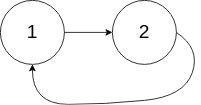Given a linked list, determine if it has a cycle in it.
To represent a cycle in the given linked list, we use an integer pos which represents the position (0-indexed) in the linked list where tail connects to. If pos is -1, then there is no cycle in the linked list.
Input: head = [3,2,0,-4], pos = 1 Output: true Explanation: There is a cycle in the linked list, where tail connects to the second node.
Input: head = [1,2], pos = 0 Output: true Explanation: There is a cycle in the linked list, where tail connects to the first node.
Input: head = [1], pos = -1 Output: false Explanation: There is no cycle in the linked list.
Can you solve it using O(1) (i.e. constant) memory?
# Definition for singly-linked list.# class ListNode:# def __init__(self, x):# self.val = x# self.next = NoneclassSolution: defhasCycle(self, head: ListNode) ->bool: nodes=set() whilehead: ifheadinnodes: returnTruenodes.add(head) head=head.nextreturnFalse# Definition for singly-linked list.# class ListNode:# def __init__(self, x):# self.val = x# self.next = NoneclassSolution: defhasCycle(self, head: ListNode) ->bool: slow, fast=head, headwhilefastandfast.next: slow=slow.nextfast=fast.next.nextifslow==fast: returnTruereturnFalse

